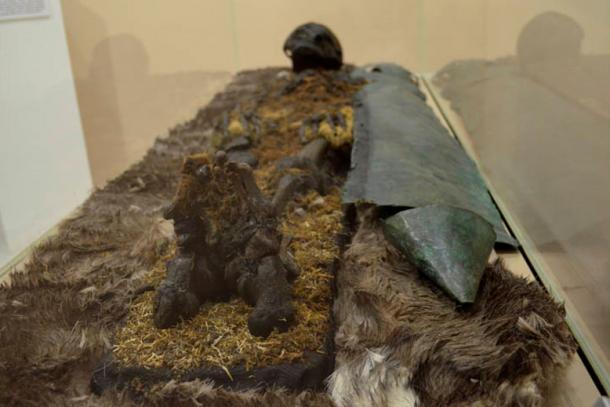
Ancient mummy unearthed from lost medieval civilization near Arctic, claim scientists
By Anna Liesowska / The Siberian Times
New find at Zeleny Yar necropolis, which shows links to Persia, are to be examined within weeks. The expected but as yet unopened human remains are wrapped in birch bark and it is likely that this 'cocoon' contains copper which - combined with the permafrost - produced an accidental mummification.
Archeologists working at the site, near Salekhard, say they suspect the remains are of a child or teenager from the 12th or 13th centuries AD.
The new find matches others discovered at Zeleny Yar, belonging to a mystery medieval civilization with links to Persia despite its position on the edge of the Siberian Arctic. If confirmed, it will be the first mummy from the civilisation found at this intriguing site since 2002.
Fellow of the Research Center for the Study of Arctic, Alexander Gusev, said: 'We decided, after consulting with colleagues, to take the find as a whole piece, that is without opening it in the field, taking for further research in the city.'
Checks with a metal detector show there is indeed metal beneath the birch bark. 'The birch bark 'cocoon' is of 1.30 metres in length and about 30 cm at the widest part.
'It follows the contours of the human body. If there is really a mummy, the head and skull are likely to be in good condition. We think it is a child, maybe a teenager. The find is now in Salekhard, in the Shemanovsky Museum, in special freezer. We plan to return to Salekhard on 15 July and immediately start the opening of the 'cocoon'.


'The find is now in Salekhard, in the Shemanovsky Museum, in special freezer. We plan to return to Salekhard on 15 July and immediately start the opening of the 'cocoon'.' Pictures: Vesti.Yamal
Anthropologist Evgeniya Syatova will be among those examining the discovery which, hope experts, will throw light on this tribe and its origins. She is leading archeologist at the Scientific and Production Center for the Protection and Use of Historical and Cultural Monuments, Sverdlovsk region.
'The mummification was natural,' said Mr Gusev. 'It was combination of factors: the bodies were overlain with copper sheets, parts of copper kettles and together with the permafrost, this it gave the preserving effect.'
Local Vesti.Yamal TV came to the site as the find was made. Their images show it being removed from the ground.
Previously, archeologists found 34 shallow graves at the medieval site, including 11 bodies with shattered or missing skulls, and smashed skeletons. Five mummies were found to be shrouded in copper, while also elaborately covered in reindeer, beaver, wolverine or bear fur. Among the graves found so far is just one female, a child, her face masked by copper plates. There are no adult women.
Nearby were found three copper masked infant mummies - all males. They were bound in four or five copper hoops, several centimetres wide.
Similarly, a red-haired man was found, protected from chest to foot by copper plating. In his resting place, was an iron hatchet, furs, and a head buckle made of bronze depicting a bear.



Five mummies were found to be shrouded in copper, while also elaborately covered in reindeer, beaver, wolverine or bear fur. Pictures: The Siberian Times, Natalya Fyodorova
The feet of the deceased are all pointing towards the Gorny Poluy River, a fact which is seen as having religious significance. The burial rituals are unknown to experts.
Artifacts included bronze bowls originating in Persia, some 3,700 miles to the south-west, dating from the tenth or eleventh centuries. One of the burials dates to 1282, according to a study of tree rings, while others are believed to be older.
The researchers found by one of the adult mummies an iron combat knife, silver medallion and a bronze bird figurine. These are understood to date from the seventh to the ninth centuries.
Unlike other burial sites in Siberia, for example in the permafrost of the Altai Mountains, or those of the Egyptian pharaohs, the purpose did not seem to be to mummify the remains, hence the claim that their preservation until modern times was an accident.


'A red-haired man was found, protected from chest to foot by copper plating. In his resting place, was an iron hatchet, furs, and a head buckle made of bronze depicting a bear.' Pictures: Kate Baklitskaya, Go East
The soil in this spot is sandy and not permanently frozen. A combination of the use of copper, which prevented oxidation, and a sinking of the temperature in the 14th century, is behind the good condition of the remains today.
Natalia Fyodorova, of the Ural branch of the Russian Academy of Sciences, said previously: 'Nowhere in the world are there so many mummified remains found outside the permafrost or the marshes.
'It is a unique archaeological site. We are pioneers in everything from taking away the object of sandy soil (which has not been done previously) and ending with the possibility of further research.'
In 2002, archeologists were forced to halt work at the site due to objections by locals on the Yamal peninsula, a land of reindeer and energy riches known to locals as 'the end of the earth'.
Featured image: Archeologists working at the site, near Salekhard, say they suspect the remains are of a child or teenager from the 12th or 13th centuries AD. Picture: Vesti.Yamal
The article ‘Ancient 'mummy' unearthed from 'lost medieval civilisation' near Arctic, claim scientists’ was originally published on The Siberian Times and has been republished with permission.
















Comments
wow! how did they aquire persian artefacts? maybe a followup?
infinitesimal waveparticles comprise what we call home the earth
manipulatable by thought ability supressed in humans since birth
This is absolutely incredible!